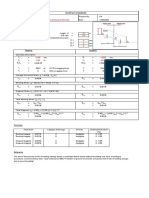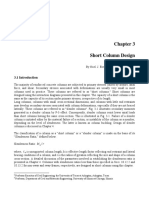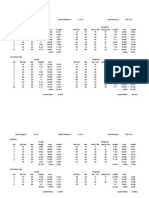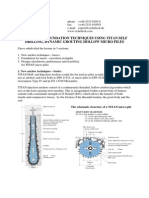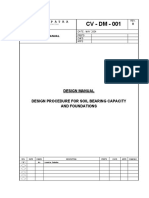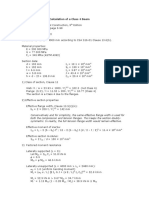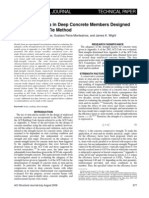Class 4 Beam
Uploaded by
sori1386Class 4 Beam
Uploaded by
sori1386Moment Resistance Calculation of a Class 4 Beam CISC Handbook of Steel Construction, 9th Edition Beam Selection Table, page
5-98 Beam section: W150x22 Calculate Mr for L = 4000 mm according to CSA S16-01 Clause 13.6(b). Material properties: E = 200 000 MPa G = 77 000 MPa Fy = 345 MPa (ASTM A992) Section data: d = 152 mm b = 152 mm t = 6.6 mm w = 5.8 mm h = d 2t = 138.8 mm 1) Class of section, Clause 11 Web: h / w = 23.93 < 1900 / Fy0.5 = 102.3 (not Class 4) Flange: (b/2) / t = 11.52 > 200 / Fy0.5 = 10.77 (Class 4) The section is a Class 4 due to the flanges. 2) Effective section properties Effective flange width, Clause 13.5(c)(iii): be = 2 200 t / Fy0.5 = 142 mm Conservatively and for simplicity, the same effective flange width is used for both the compression and tension flanges. This keeps the section doublysymmetric. In reality, the full tension flange width would remain effective. Effective moment of inertia: Ixe = Ix 2 (b be) t3 / 12 2 (b be) t (d / 2 t / 2)2 = 11.4 106 mm4 Effective section modulus: Sxe = 2 Ixe / d = 150 103 mm3 3) Factored moment resistance Laterally supported (L = 0): Let Mye = Sxe Fy = 51.8 kNm = 0.9 Mr0 = Mye = 46.6 kNm Laterally unsupported (L = 4000 mm > Lu = 2480 mm): 2 = 1.0 (uniform bending moment) Mu = (2 / L) [E Iy G J + ( E / L)2 Iy Cw]0.5 = 52.9 kNm Mu = 52.9 kNm > 0.67 Mye = 34.7 kNm Mr = 1.15 Mr0 (1 0.28 Mye / Mu) = 38.9 kNm Mr0 Ix = 12.1 106 mm4 Sx = 150 103 mm3 Iy = 3.87 106 mm4 J = 43.4 103 mm4 Cw = 20.4 109 mm6
You might also like
- Elements of Soil Mechanics, 8th Edition Bearing Capacity FactorsNo ratings yetElements of Soil Mechanics, 8th Edition Bearing Capacity Factors14 pages
- STAAD - Difference Between Surface Element, PlateNo ratings yetSTAAD - Difference Between Surface Element, Plate4 pages
- Design of Wall For Water Tank Water & EarthNo ratings yetDesign of Wall For Water Tank Water & Earth19 pages
- 2 ULS - Bending With or Without Axial Force (2014) PDFNo ratings yet2 ULS - Bending With or Without Axial Force (2014) PDF15 pages
- CRJGR Aayu STS Inf S2.0 CNS RTW 00004C CC 22 11 PDFNo ratings yetCRJGR Aayu STS Inf S2.0 CNS RTW 00004C CC 22 11 PDF28 pages
- UGC-02 - DSR - Design of Traffic Decking and Gantry Support System at Girgaon StationNo ratings yetUGC-02 - DSR - Design of Traffic Decking and Gantry Support System at Girgaon Station10 pages
- Ruj. Catatan: Dead Load From Beam, DL KN Live Load From Beam, LL KNNo ratings yetRuj. Catatan: Dead Load From Beam, DL KN Live Load From Beam, LL KN5 pages
- Analysis of Railway Bridge Steel Sections With Different Type of Trusses For 32.5 Tonne Axle LoadingNo ratings yetAnalysis of Railway Bridge Steel Sections With Different Type of Trusses For 32.5 Tonne Axle Loading10 pages
- Stress Analysis Using Photoelasticity Technique - A ReviewNo ratings yetStress Analysis Using Photoelasticity Technique - A Review5 pages
- Chapter 3 - SP17 - 09-07 - Excluding MP Diagrams - PDFNo ratings yetChapter 3 - SP17 - 09-07 - Excluding MP Diagrams - PDF17 pages
- Bearing Capacity of Driven Pile 20201110No ratings yetBearing Capacity of Driven Pile 202011105 pages
- 00 BOOK Foundation Analysis and Design (JE Bowles)No ratings yet00 BOOK Foundation Analysis and Design (JE Bowles)1,241 pages
- Design of Box Culvert Type Section (E-E)No ratings yetDesign of Box Culvert Type Section (E-E)4 pages
- Sda-02-Dd-02 - Pile & Pile Cap - Sheet-1 - R0No ratings yetSda-02-Dd-02 - Pile & Pile Cap - Sheet-1 - R01 page
- Material Properties:: Main Builtup Girder Flexural CheckNo ratings yetMaterial Properties:: Main Builtup Girder Flexural Check22 pages
- Moment Resistance Calculation of A Class 4 BeamNo ratings yetMoment Resistance Calculation of A Class 4 Beam1 page
- Moment Resistance Calculation of A Class 4 BeamNo ratings yetMoment Resistance Calculation of A Class 4 Beam1 page
- Design of Steel Structure (Chapter 2) by DR R BaskarNo ratings yetDesign of Steel Structure (Chapter 2) by DR R Baskar57 pages
- 103-s61 Strength of Struts in Deep Concrete Members Designed Using Strut-And-Tie MethodNo ratings yet103-s61 Strength of Struts in Deep Concrete Members Designed Using Strut-And-Tie Method10 pages
- Teaching Numerical Analysis With MathcadNo ratings yetTeaching Numerical Analysis With Mathcad17 pages
- Chapter 4-Plates Subjected To Transverse LoadsNo ratings yetChapter 4-Plates Subjected To Transverse Loads53 pages
- 103-s61 Strength of Struts in Deep Concrete Members Designed Using Strut-And-Tie MethodNo ratings yet103-s61 Strength of Struts in Deep Concrete Members Designed Using Strut-And-Tie Method10 pages
- Teaching Numerical Analysis With MathcadNo ratings yetTeaching Numerical Analysis With Mathcad17 pages
- A User's Guide To - Knee Injury and Osteoarthritis Outcome Score KOOS - KOOSGuide2003No ratings yetA User's Guide To - Knee Injury and Osteoarthritis Outcome Score KOOS - KOOSGuide20039 pages















